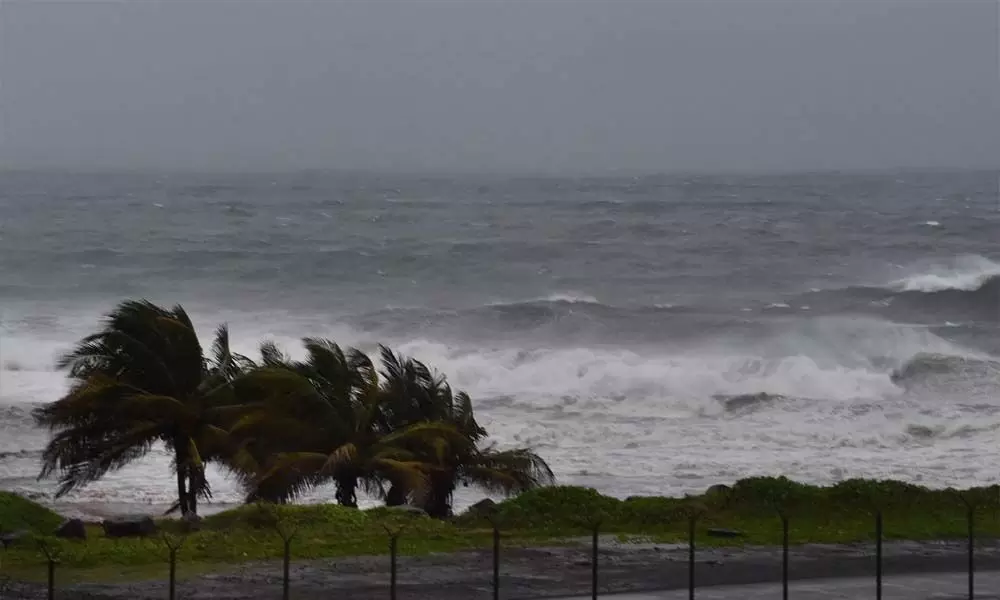Live
- From Data Silos to Unified Insights: How Cash Flow Management SaaS is Transforming Organizational Finance
- Top Personalities Who Made A Significant Mark In Their Particular Sector In 2024
- ‘Vaaradhi’ set for Dec 27 release, pre-release event held
- ‘Daaku Maharaaj’ team expresses confidence on film; set for Jan 12 release
- ‘It’s Okay Guru’ drops soulful song with actor Siddharth vocals
- Kichcha Sudeep’s ‘Max’ trailer looks powerful
- Bengal school job case: Court rejects accused's plea to return to US by Jan 2
- ‘Drinker Sai’ appeals to both younger and family audiences: Producer Basavaraju Laharidhar
- Kerala BJP’s ‘love’ towards Christians is fake: Ex party leader
- Google Gemini Now Features PDF Screen Awareness in the Files App
Just In
Hurricane Elsa Churns Across Caribbean Toward Cuba, Florida


Hurricane Elsa Churns Across Caribbean Toward Cuba, Florida
Elsa, the first hurricane of the 2021 Atlantic storm season, is churning quickly across the Caribbean, aiming for Hispaniola, Cuba and eventually Florida as extreme weather batters the Northern Hemisphere.
Elsa, the first hurricane of the 2021 Atlantic storm season, is churning quickly across the Caribbean, aiming for Hispaniola, Cuba and eventually Florida as extreme weather batters the Northern Hemisphere.
The storm was about 285 miles (460 kilometers) east-southeast of the Dominican Republic, the U.S. National Hurricane Center said in an update at 2 a.m. Atlantic standard time on Saturday. It had maximum sustained winds of 80 miles per hour.
Elsa, moving at 29 mph, is on track to clip the Dominican Republic on Saturday, move near Jamaica on Sunday, then cross Cuba, before approaching Florida. Hurricane conditions are forecast in parts of Hispaniola later Saturday. "Some restrengthening is possible today, but slow weakening is expected to begin tonight or Sunday as Elsa interacts" with nearby landmasses, the center said.
The category 1 system is the Atlantic's fifth named storm in what forecasters expect will be an unusually busy season. It marks first time in modern records that the basin has produced that many storms so early. Elsa comes on the heels of a record heat wave that is searing Canada and the Northwest U.S. and as extreme temperatures have smothered China, Eastern Europe and elsewhere.
The storm's track in the coming days remains uncertain.
The National Hurricane Center's forecast calls for the storm to roll over northwest Cuba and then strike Florida's west coast. There's also a "significant possibility" it could veer deeper into the Gulf of Mexico, where it could strengthen over warmer waters, said Jim Rouiller, chief meteorologist at the Energy Weather Group.
The oil and gas industry in the Gulf must "watch very closely" as they may need to evacuate some staff, he said, adding that he sees the makings of a repeat of Hurricane Dennis in 2005. That grew rapidly into a major, deadly storm that hit Florida's Panhandle -- also on the U.S. Fourth of July weekend.
European and Canadian models, meanwhile, show Elsa possibly moving up Florida's east coast instead, said Matt Rogers, president of Commodity Weather Group.
Either way, the models currently predict it will weaken over Hispaniola and Cuba. It could produce some heavy rain and scattered power outages in the U.S. but probably not serious damage, Rogers said.
He said he doesn't expect widespread problems for agriculture or energy interests at this point, but that could change if Elsa strays farther to the south, skirting the islands and entering the Gulf relatively unobstructed. "It's a very low risk, but you never say never with tropical weather," Rogers said.
For the moment, Elsa is the strongest storm to hit the eastern Caribbean in July since Emily in 2005, Phil Klotzbach, lead author of the Colorado State University seasonal hurricane forecast, said in a tweet. He also noted it's the farthest east an Atlantic hurricane has formed this early since 1933.
Elsa formed between the Caribbean and Africa, a significant factor because storms originating there before August often mean that the hurricane season as a whole could be quite active, according to Ryan Truchelut, chief meteorologist at WeatherTiger LLC in Tallahassee, Florida.
"This is not a normal threat in terms of timing and location," Truchelut said. "There's really only a handful of historical precedents for a threat coming out of the tropical Atlantic or eastern Caribbean in early July."
Hurricane warnings have been issued for much of the Caribbean, including the south coast of the Dominican Republic and southern Haiti. The hurricane center said little change in strength is forecast through Saturday and that some decrease in winds is possible on Monday as Elsa passes over Cuba.
"The fact that we're already ahead of last year's torrid pace of tropical storms is somewhat concerning," said Randy Adkins, a senior meteorologist with AccuWeather Inc. Having five storms this soon in the year "is confirming to us we were on track with a busier season on average."

© 2024 Hyderabad Media House Limited/The Hans India. All rights reserved. Powered by hocalwire.com






